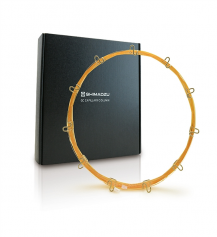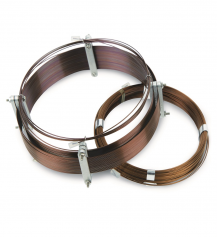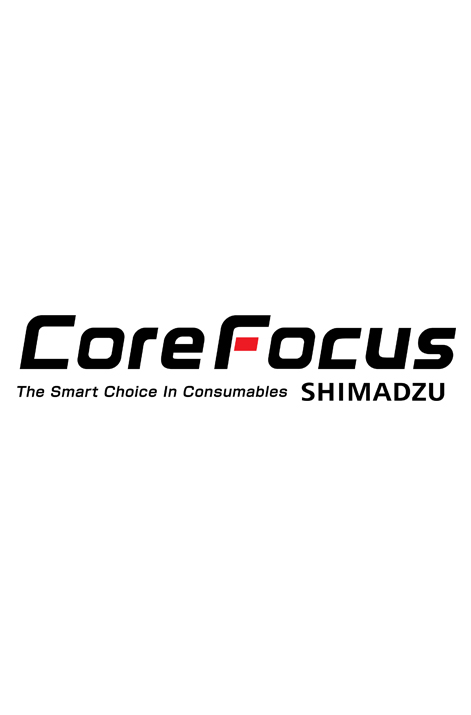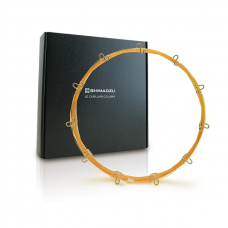GC Columns
Product Listing
-
Description:
Application-specific columns for volatile organic pollutants. Excellent for U.S. EPA Method 8021 compounds. The SH-VRX stationary phase and optimized column dimensions provide low bleed, excellent resolution, and fast analysis times for volatile compounds.
OUT OF STOCKApplication-specific columns for volatile organic pollutants. Excellent for U.S. EPA Method 8021 compounds. The SH-VRX stationary phase and optimized column dimensions provide low bleed, excellent resolution, and fast analysis times for volatile compounds.
-
Description:
Mid-polarity phase: Crossbond™ 6% cyanopropylphenyl / 94% dimethyl polysiloxane Application-specific columns for volatile organic pollutants. Recommended in U.S. EPA methods for volatile organic pollutants. Equivalent to USP G43 phase. Similar phases: HP-624, DB-624, DB-624 UI, VF-624ms, SPB-1301
OUT OF STOCKMid-polarity phase: Crossbond™ 6% cyanopropylphenyl / 94% dimethyl polysiloxane Application-specific columns for volatile organic pollutants. Recommended in U.S. EPA methods for volatile organic pollutants. Equivalent to USP G43 phase. Similar phases: HP-624, DB-624, DB-624 UI, VF-624ms, SPB-1301
-
Description:
Low-polarity phase: Crossbond™ 5% diphenyl / 95% dimethyl polysiloxane Dedicated columns for amines and other basic compounds, including alkylamines, diamines, triamines, ethanolamines, and nitrogen-containing heterocyclics.
LOW STOCKLow-polarity phase: Crossbond™ 5% diphenyl / 95% dimethyl polysiloxane Dedicated columns for amines and other basic compounds, including alkylamines, diamines, triamines, ethanolamines, and nitrogen-containing heterocyclics.
-
Description:
Non-polar phase: Crossbond™ 100% dimethyl polysiloxane General-purpose columns for solvent impurities, PCB congeners (e.g., Aroclor mixes), simulated distillation, arson accelerants, gases, natural gas odorants, sulfur compounds, essential oils, hydrocarbons, semi-volatiles, pesticides, oxygenates. Equivalent to USP G1, G2, G38 phases. Similar phases: HP-1, DB-1, CP Sil 5 CB, SPB-1, Rtx-1 Integrated Guard Columns No leaks for a more robust method. No column connections for easier, faster maintenance. No peak distortions due to connector dead volume and thermal capacity. For column without Integra-Guard column, please refer to 221-75732-30
OUT OF STOCKNon-polar phase: Crossbond™ 100% dimethyl polysiloxane General-purpose columns for solvent impurities, PCB congeners (e.g., Aroclor mixes), simulated distillation, arson accelerants, gases, natural gas odorants, sulfur compounds, essential oils, hydrocarbons, semi-volatiles, pesticides, oxygenates. Equivalent to USP G1, G2, G38 phases. Similar phases: HP-1, DB-1, CP Sil 5 CB, SPB-1, Rtx-1 Integrated Guard Columns No leaks for a more robust method. No column connections for easier, faster maintenance. No peak distortions due to connector dead volume and thermal capacity. For column without Integra-Guard column, please refer to 221-75732-30
-
Description:
Tested with a basic amine test mix. Excellent inertness for basic compounds. Recommended for use with SH-5 Amine, SH-35 Amine, SH-Volatile Amine, and SH-PolarX capillary columns. Batch test chromatogram included. Maximum temperature: 315 °C. Chemists using guard columns in the analyses of basic compounds frequently observe peak tailing and low recovery. This happens because conventionally deactivated tubing surfaces can be adsorptive to basic compounds. Shimadzu offers basedeactivated guard columns, as well as base-deactivated inlet liners, for completely inert sample pathways.
OUT OF STOCKTested with a basic amine test mix. Excellent inertness for basic compounds. Recommended for use with SH-5 Amine, SH-35 Amine, SH-Volatile Amine, and SH-PolarX capillary columns. Batch test chromatogram included. Maximum temperature: 315 °C. Chemists using guard columns in the analyses of basic compounds frequently observe peak tailing and low recovery. This happens because conventionally deactivated tubing surfaces can be adsorptive to basic compounds. Shimadzu offers basedeactivated guard columns, as well as base-deactivated inlet liners, for completely inert sample pathways.
-
Description:
Tested with a basic amine test mix. Excellent inertness for basic compounds. Recommended for use with SH-5 Amine, SH-35 Amine, SH-Volatile Amine, and SH-PolarX capillary columns. Batch test chromatogram included. Maximum temperature: 315 °C. Chemists using guard columns in the analyses of basic compounds frequently observe peak tailing and low recovery. This happens because conventionally deactivated tubing surfaces can be adsorptive to basic compounds. Shimadzu offers basedeactivated guard columns, as well as base-deactivated inlet liners, for completely inert sample pathways.
OUT OF STOCKTested with a basic amine test mix. Excellent inertness for basic compounds. Recommended for use with SH-5 Amine, SH-35 Amine, SH-Volatile Amine, and SH-PolarX capillary columns. Batch test chromatogram included. Maximum temperature: 315 °C. Chemists using guard columns in the analyses of basic compounds frequently observe peak tailing and low recovery. This happens because conventionally deactivated tubing surfaces can be adsorptive to basic compounds. Shimadzu offers basedeactivated guard columns, as well as base-deactivated inlet liners, for completely inert sample pathways.
-
Description:
Tested with a basic amine test mix. Excellent inertness for basic compounds. Recommended for use with SH-5 Amine, SH-35 Amine, SH-Volatile Amine, and SH-PolarX capillary columns. Batch test chromatogram included. Maximum temperature: 315 °C. Chemists using guard columns in the analyses of basic compounds frequently observe peak tailing and low recovery. This happens because conventionally deactivated tubing surfaces can be adsorptive to basic compounds. Shimadzu offers basedeactivated guard columns, as well as base-deactivated inlet liners, for completely inert sample pathways.
OUT OF STOCKTested with a basic amine test mix. Excellent inertness for basic compounds. Recommended for use with SH-5 Amine, SH-35 Amine, SH-Volatile Amine, and SH-PolarX capillary columns. Batch test chromatogram included. Maximum temperature: 315 °C. Chemists using guard columns in the analyses of basic compounds frequently observe peak tailing and low recovery. This happens because conventionally deactivated tubing surfaces can be adsorptive to basic compounds. Shimadzu offers basedeactivated guard columns, as well as base-deactivated inlet liners, for completely inert sample pathways.
-
Description:
Polar polyethylene glycol deactivation Tested with a comprehensive test mix to ensure high inertness. Polyethylene glycol deactivation layer provides optimum wettability for polar compounds. Minimize peak splitting when using polar solvents such as methanol or water. Compatible with SH-PolarWax, SH-225 and SH-2330 capillary columns. Maximum temperature: 280 °C.
OUT OF STOCKPolar polyethylene glycol deactivation Tested with a comprehensive test mix to ensure high inertness. Polyethylene glycol deactivation layer provides optimum wettability for polar compounds. Minimize peak splitting when using polar solvents such as methanol or water. Compatible with SH-PolarWax, SH-225 and SH-2330 capillary columns. Maximum temperature: 280 °C.
-
Description:
Polar polyethylene glycol deactivation Tested with a comprehensive test mix to ensure high inertness. Polyethylene glycol deactivation layer provides optimum wettability for polar compounds. Minimize peak splitting when using polar solvents such as methanol or water. Compatible with SH-PolarWax, SH-225 and SH-2330 capillary columns. Maximum temperature: 280 °C.
OUT OF STOCKPolar polyethylene glycol deactivation Tested with a comprehensive test mix to ensure high inertness. Polyethylene glycol deactivation layer provides optimum wettability for polar compounds. Minimize peak splitting when using polar solvents such as methanol or water. Compatible with SH-PolarWax, SH-225 and SH-2330 capillary columns. Maximum temperature: 280 °C.
-
Description:
Polar polyethylene glycol deactivation Tested with a comprehensive test mix to ensure high inertness. Polyethylene glycol deactivation layer provides optimum wettability for polar compounds. Minimize peak splitting when using polar solvents such as methanol or water. Compatible with SH-PolarWax, SH-225 and SH-2330 capillary columns. Maximum temperature: 280 °C.
OUT OF STOCKPolar polyethylene glycol deactivation Tested with a comprehensive test mix to ensure high inertness. Polyethylene glycol deactivation layer provides optimum wettability for polar compounds. Minimize peak splitting when using polar solvents such as methanol or water. Compatible with SH-PolarWax, SH-225 and SH-2330 capillary columns. Maximum temperature: 280 °C.
-
Description:
Midpolarity Crossbond™ phase General-purpose columns for alcohols, oxygenates, PCB congeners (e.g., Aroclor mixes), and pesticides. Equivalent to USP G46 phase. 4.5" standard coil diameter. Similar phase: DB-PS1701
OUT OF STOCKMidpolarity Crossbond™ phase General-purpose columns for alcohols, oxygenates, PCB congeners (e.g., Aroclor mixes), and pesticides. Equivalent to USP G46 phase. 4.5" standard coil diameter. Similar phase: DB-PS1701
-
Description:
Polar phase; Crossbond™ Carbowax polyethylene glycol—provides oxidation resistance General-purpose columns for FAMEs, flavor compounds, essential oils, amines, solvents, xylene isomers, and U.S. EPA Method 603 (acrolein/acrylonitrile). Equivalent to USP G14, G15, G16, G20, and G39 phases. 4.5" standard coil diameter.
OUT OF STOCKPolar phase; Crossbond™ Carbowax polyethylene glycol—provides oxidation resistance General-purpose columns for FAMEs, flavor compounds, essential oils, amines, solvents, xylene isomers, and U.S. EPA Method 603 (acrolein/acrylonitrile). Equivalent to USP G14, G15, G16, G20, and G39 phases. 4.5" standard coil diameter.
Leading Supplier for GC Column & Customised GC Column in Singapore
Gas chromatography, or GC, is undoubtedly one of the essential techniques in separating volatile compounds. It is helpful in the fields of health, medicine, drug analysis, food science, and more. It plays a crucial role in the fields of food and agriculture, industrial and environment, energy and chemical. Therefore, it requires precision and infallible GC columns to ensure attested analysis.
At Shimadzu, we ensure our GC consumables span a broad range to suit your analytical needs. We provide GC columns, PLOT columns and customised GC columns. Our GC column provides the best solution for most applications giving reliable and reproducible results.
Highly Reproducible Results and Accuracy
Our GC columns and consumables are designed to complete your Shimadzu GC System. Shimadzu understands your chromatography analysis does not end with the selection of the GC column. The combination of components selected for your Shimadzu instrument makes an important contribution to successful chromatography. Shimadzu GC columns are designed to provide you with the best separation performance with highly reproducible and reliable results for your GC applications.
Accurate Peak Identification and Quantification in GC Analysis with Shimadzu GC Columns
Elevate your GC analysis with Shimadzu GC Columns, designed to ensure precise peak identification and quantification. Our columns are engineered using cutting-edge technology, delivering exceptional separation capabilities. Whether you're dealing with complex samples or routine analyses, Shimadzu GC Columns provide the accuracy you need to confidently identify and quantify peaks. Trust in our columns to deliver reliable results, enabling you to achieve the highest standards of analytical excellence in your chromatographic endeavors.
High-Quality Materials for Optimal Performance
Shimadzu prioritises quality and performance when it comes to the materials used in our GC columns. We carefully select premium-grade materials with excellent thermal stability, low bleed characteristics, and high inertness. Using these high-quality materials ensures optimal column performance, minimising background interference and maximising sensitivity for your capillary column GC applications.
Versatile Applications for Diverse Needs
Shimadzu has a wide range of GC Columns available including Fused Silica Capillary Columns, Fused Silica PLOT Columns, Stainless Steel Columns, Guard Columns and application specific columns. Whether you require analysis in pharmaceuticals, environmental testing, food and beverages, or materials science, our GC columns are designed to deliver accurate and precise results. Shimadzu GC columns are manufactured to the highest industry standard and designed to provide excellent chromatographic performance, reproducibility and lifetime complementing any GC/GC-MS instrument.
GC Guard Columns for Enhanced Protection
For enhanced performance and extended column life, Shimadzu also offers GC guard columns. These columns act as protective barriers, shielding the primary GC column by capturing contaminants or particles. By utilising a guard column, you can increase the lifespan of the GC column and save costs.
Customised Solutions for Specific Requirements
Shimadzu understands that each GC column application is unique, and specific requirements may arise. That's why we offer customised GC columns tailored to your particular needs. Our team of experts collaborates closely with you to have a clear idea of your application and recommend or develop a custom GC column that meets your precise specifications. This personalised approach ensures you achieve optimal results and efficiency in your analytical processes.
Reliable GC Column Application at Shimadzu
GC columns and customised GC columns are the solutions to various GC column applications. In order to cater to your GC application requirements, Shimadzu offers a wide range and high-quality GC columns, capillary columns, metal columns, PLOT, and customised GC columns. We can provide you with dedicated capillary columns for GC used for pesticide analysis, analysis of fatty acid methyl esters (FAME) analysis, blood alcohol analysis, PCB analysis, volatile amine analysis and many other GC applications.
High performance columns for highest inertness and excellent performance
Shimadzu’s series of high-quality capillary columns provides the highest inertness and excellent performance. Our high-performance columns deliver exceptional temperature stability, leading to minimal bleeding properties and heightened system sensitivity. This enables achieving reduced limits of detection (LOD), quicker system stabilization, and shortened conditioning times.
Metal Columns: Ideal for Specific Applications
Shimadzu's metal columns are specially designed for specific applications that require unique characteristics not found in traditional columns. Metal columns offer superior performance in applications such as sulphur compounds, permanent gases, and metal analyses. These GC columns provide excellent stability, robustness, and selectivity, enabling precise analysis of challenging samples in various industries.
PLOT Columns: Enhanced Separation for Complex Matrices
Our PLOT (Porous Layer Open Tubular) columns excel in analysing complex matrices and volatile compounds. The unique porous structure of PLOT columns allows for enhanced separation and analysis of typically difficult to resolve components. These columns are particularly suited for environmental analysis, forensic analysis, and volatile organic compounds (VOCs) analysis. PLOT columns offer superior retention capacity and can withstand challenging sample matrices, ensuring accurate and reliable results.
Dedicated columns for dedicated applications and analytes
In order to solve chromatographic challenges, we provide an array of specific GC columns for dedicated applications like EPA methods, food analysis, clinical samples and more. These columns and stationary phases have been fine-tuned and rigorously tested to deliver optimal separation, precise quantification, and rapid analysis durations.
Customisation of GC Columns same as Customised Solutions for Specific Requirements???
Each analytical challenge is unique; sometimes, standard GC columns may only partially meet your specific requirements. Shimadzu offers customisation services for GC columns, allowing you to tailor the column to your specifications.
Our customised GC columns are available in either glass or stainless-steel tubing, and you can choose the diameter, length, solid support material, coated phase, and mesh size that best suits your analytical needs. By submitting your request for a customised GC column to Shimadzu, you can enhance the performance and efficiency of your analyses by obtaining a column GC designed specifically for your application.
H2GC Guard Column and Retention Gap Column Supplier Based in Singapore
Shimadzu GC guard columns and retention gap columns can be used for a varied range of applications and extend the lifetime of a column. These GC guard columns are compatible with the most commonly used solvents. They are manufactured and individually tested to ensure accuracy, inertness, and outstanding performance.
Trust Shimadzu for your GC column and customised GC column needs. We have an extensive catalogue of GC consumables that can help you stock up on your lab consumables. Contact us today and we will assist you in selecting the right GC column and consumables for your GC column applications.
Frequently Asked Questions About GC Columns
1. What is the function of a GC column?
Gas chromatography (GC) columns are essential to gas chromatography as they are used in separating complex mixtures. It is a crucial tool used and applied in analytical chemistry as it is efficient, and effective. It is made up of a glass-like material called fused silica coated with a layer of stationary phase that interacts with the analytes as it goes through the column. This interaction results in the separation of the more volatile compounds from the less volatile ones.
2. What are the types of GC columns?
There are two types of gas chromatography (GC) columns - packed columns and capillary columns. Packed columns are short and thick columns made of stainless steel or glass. These GC columns have low separation performance and create broad, peaked shapes in the chromatogram. Packed columns are less susceptible to contamination and can handle larger sample volumes.
Capillary columns are currently the most common GC column type. These columns have superior separation performance and are ideal for highly sensitive separation and analysis. Capillary columns create sharper peaks resulting in higher sensitivity and lower detection limit.
















